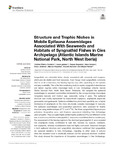Mostrar o rexistro simple do ítem
Structure and Trophic Niches in Mobile Epifauna Assemblages Associated With Seaweeds and Habitats of Syngnathid Fishes in Cíes Archipelago (Atlantic Islands Marine National Park, North West Iberia)
| dc.contributor.author | Piñeiro-Corbeira, Cristina | |
| dc.contributor.author | Iglesias, Laura | |
| dc.contributor.author | Nogueira, Raquel | |
| dc.contributor.author | Campos, Sara | |
| dc.contributor.author | Jiménez, Arturo | |
| dc.contributor.author | Regueira, Marcos | |
| dc.contributor.author | Barreiro, Rodolfo | |
| dc.contributor.author | Planas Oliver, Miquel | |
| dc.date.accessioned | 2022-03-16T09:53:11Z | |
| dc.date.available | 2022-03-16T09:53:11Z | |
| dc.date.issued | 2021-11-11 | |
| dc.identifier.citation | Piñeiro-Corbeira C, Iglesias L, Nogueira R, Campos S, Jiménez A, Regueira M, Barreiro R and Planas M (2021) Structure and Trophic Niches in Mobile Epifauna Assemblages Associated With Seaweeds and Habitats of Syngnathid Fishes in Cíes Archipelago (Atlantic Islands Marine National Park, North West Iberia). Front. Mar. Sci. 8:773367. doi: 10.3389/fmars.2021.773367 | es_ES |
| dc.identifier.issn | 2296-7745 | |
| dc.identifier.uri | http://hdl.handle.net/2183/30012 | |
| dc.description.abstract | [Abstract] Syngnathids are vulnerable fishes closely associated with seaweeds and seagrass, which provide shelter and food resources. Even though most syngnathids commonly feed on small crustaceans, the feeding regimes may differ depending on the species and prey availability. This is the first monitoring study to explain syngnathid abundances and dietary regimes within macroalgal beds in Cíes Archipelago (Atlantic Islands Marine National Park, North West Iberian Peninsula). We sampled the epifaunal assemblages in seaweed communities dominated by the canopy-forming macroalgae Gongolaria baccata and Codium spp. seasonally during 2 years. The epifaunal structure was mostly represented by harpacticoid copepods, amphipods (especially gammarids) and gastropods. Epifauna exhibited low plant-host specificity and a higher dominance of amphipods on the more structurally complex macroalgae G. baccata. The epifaunal assemblages and syngnathid specimens were assessed for trophic structure using stable isotopes (δ13C and δ15N). The three syngnathids (Hippocampus guttulatus, Syngnathus acus, and Entelurus aequoreus) inhabiting Cíes Archipelago were sympatric. They occupied highly similar trophic positions (TPs), but differed in niche size, in such a way that the snake pipefish E. aequoreus would likely feed on smaller prey. The assessment of the feeding regime in the dominant great pipefish S. acus revealed that amphipods mostly contributed to bulk diet, followed by isopods, carideans, and copepods, whereas mysidaceans were not highly consumed. Seasonal changes in both epifaunal structure and syngnathids abundance confirmed that syngnathids are seasonal residents in Cíes Archipelago, migrating to other areas in autumn when the seaweed cover is drastically reduced and the epifaunal structure modified. This study showed the importance of Gongolaria assemblages in Cíes Archipelago, providing rich dietary sources and potentially contributing to higher abundances and diversity of syngnathids. Ongoing cover reduction in Gongolaria assemblages in certain regions (e.g., Mediterranean) should be considered a potential ecological concern for syngnathids and accompanying fauna, requiring further investigations. | es_ES |
| dc.description.sponsorship | This study was financially supported by the Spanish Government with project Hippoparques (Ref. 1541S/2015, Organismo Autónomo de Parques Nacionales de España, Ministerio para la Transición Ecológica y Reto Demográfico, MITECO, Spain) | es_ES |
| dc.language.iso | eng | es_ES |
| dc.publisher | Frontiers | es_ES |
| dc.relation | info:eu-repo/grantAgreement/MAAMA/Plan Estatal de Investigación Científica y Técnica y de Innovación 2013-2016/1541S%2F2015/ES/Signátidos de los parques nacionales de las Islas Atlánticas y del Archipiélago de Cabrera/ | |
| dc.relation.uri | https://doi.org/10.3389/fmars.2021.773367 | es_ES |
| dc.rights | Atribución 4.0 Internacional | es_ES |
| dc.rights.uri | http://creativecommons.org/licenses/by/4.0/ | * |
| dc.subject | Epifauna | es_ES |
| dc.subject | Seaweed assemblages | es_ES |
| dc.subject | Trophic web | es_ES |
| dc.subject | Stable isotopes | es_ES |
| dc.subject | Syngnathids | es_ES |
| dc.subject | National park | es_ES |
| dc.subject | Feeding regime | es_ES |
| dc.title | Structure and Trophic Niches in Mobile Epifauna Assemblages Associated With Seaweeds and Habitats of Syngnathid Fishes in Cíes Archipelago (Atlantic Islands Marine National Park, North West Iberia) | es_ES |
| dc.type | info:eu-repo/semantics/article | es_ES |
| dc.rights.access | info:eu-repo/semantics/openAccess | es_ES |
| UDC.journalTitle | Frontiers in Marine Science | es_ES |
| UDC.volume | 8 | es_ES |
| UDC.startPage | 773367 | es_ES |
| dc.identifier.doi | 10.3389/fmars.2021.773367 |






